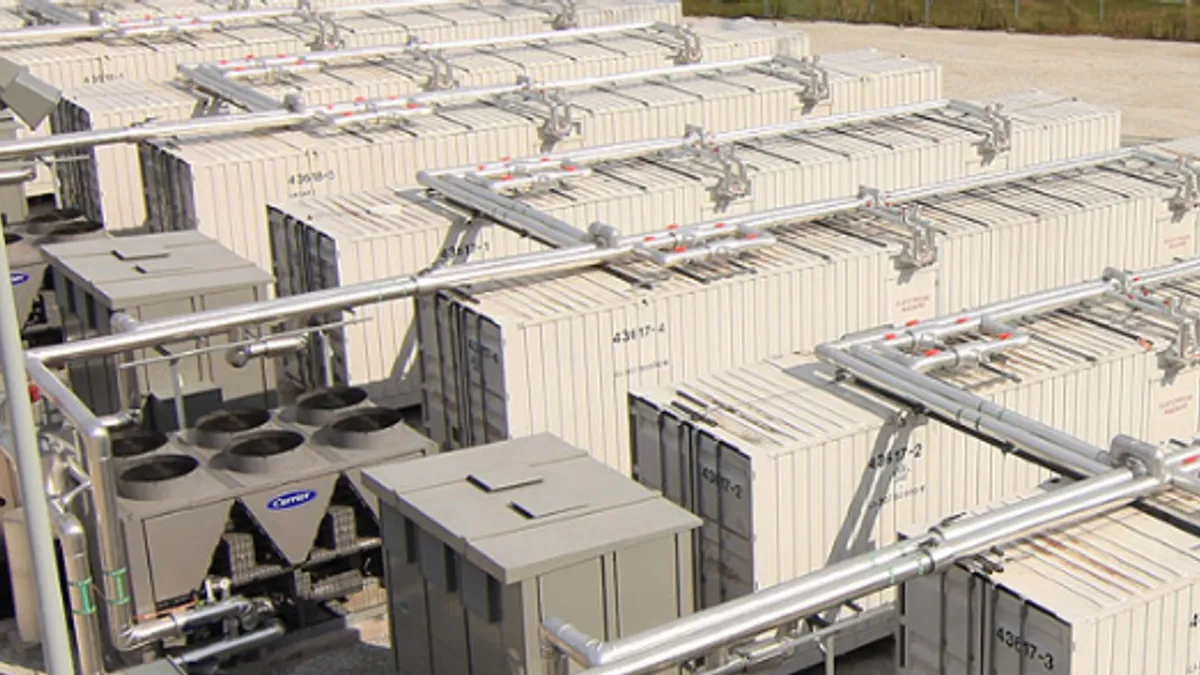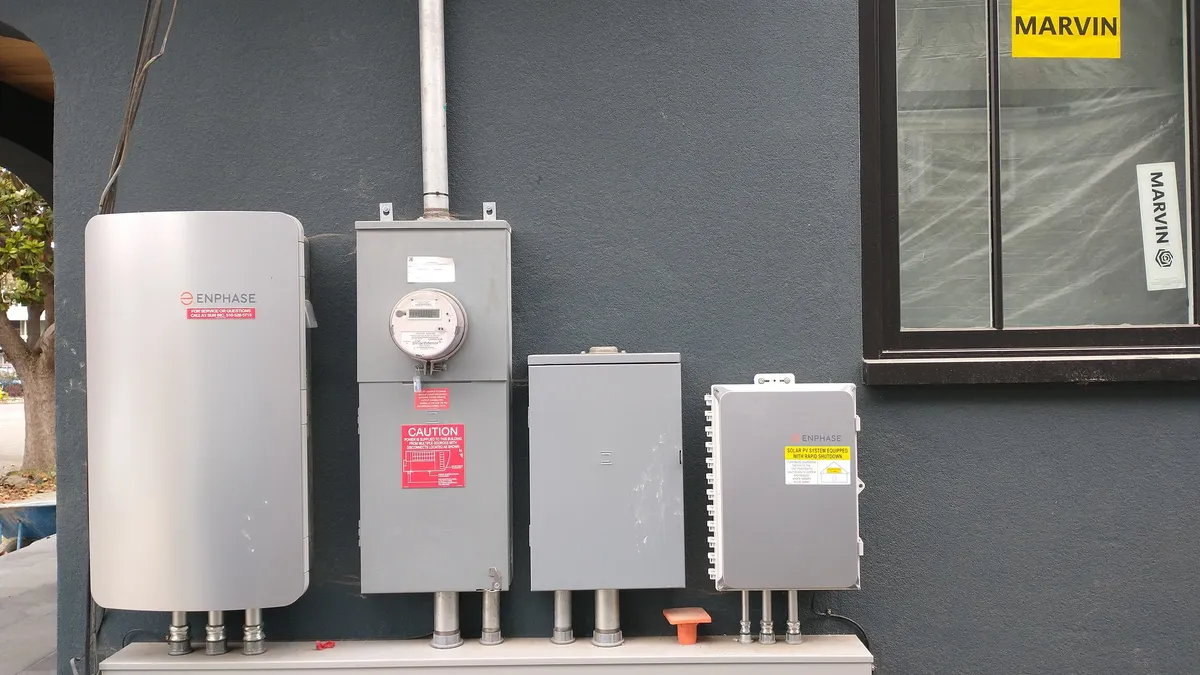How to best quantify the growth and benefits of energy storage has long puzzled energy stakeholders, but a new storage market update emphasizes two lesser known metrics that help illustrate the technology's potential.
The market continues to show robust growth for storage technologies both in front and behind the meter, though still from small base numbers, and costs continue to fall for battery technologies. But the inclusion of megawatt-hours (MWh) along with the more common megawatt (MW) measurement delivers a deeper understanding of the energy storage market. And the addition of CO2 reductions shows a new appreciation for what energy storage can do.
“60.3 MW of energy storage were deployed in Q3 2015, a twofold increase from Q3 2014 and a 46% increase from Q2 2015,” according to the Q3 2015 U.S. Energy Storage Monitor from the Energy Storage Association and GTM Research.
This year will see the deployment of 192 MW of energy storage, more than tripling 2014's total of 62 MW. By 2020, with more markets for storage opening up, annual deployment is expected to be up to 1,349 MW, which is “21 times the size of the 2014 market, and seven times the size of 2015 market,” the monitor reports.
“53.1 MWh of energy storage were deployed in Q3 2015,” the monitor adds, “a 10% increase from Q3 2014 and a fourfold increase from Q3 2013.”
New storage metrics for GTM
The Q3 data is now being reported in two metrics because of the clearer recognition of the many applications of energy storage, explained Ravi Manghani, GTM Senior Energy Storage Analyst and lead author of the report. They are broadly divided into MW power applications and MWh energy applications.
MW is a power unit — the amount of electricity the storage system can provide at any given second.
Problem is, Manghani said, "it indicates nothing about how long the storage system can keep delivering that electricity.
MWh, by contrast, is an energy unit, which measures the number of hours a storage system can deliver its rated MW capacity. “It is the number of hours the system can deliver that MW-rated power capacity,” Manghani said.
“A 1 MW, 4 MWh system can deliver 1 MW of power for 4 hours," he said.
Storage system power applications are typically short duration, like frequency regulation, Manghani said. For that, the battery acts like a vessel to absorb or deliver power moment-to-moment, depending on grid needs. “It is the number of MW that can be provided for a few seconds to a few minutes.”
“It is a continuous transaction, not a discreet transaction," Manghani said. "The battery goes up and down around a set point to match the supply and demand in the set interval.”
Most applications other than frequency regulation are either hybrid energy-power or energy applications, he said. For hybrid applications, there is a primary application of either power, or energy and secondary applications which could be power or energy.
In energy applications, “the battery is used not for a few seconds or a few minutes but for an hour or more,” Manghani explained. “The MW number is important but the system size in MWh is important, too, and that is why we are now publishing it.”
Using both metrics makes the update more complete, he said. “More importantly, as costs keep coming down and new applications start to pencil out, there will be more energy-based applications, particularly where storage is used as a capacity asset.”
As California moves toward meeting its 50% renewables by 2030 mandate, it is likely to draw on energy storage as a Resource Adequacy asset, Manghani said, and that will be an application that demands longer MWh applications. Energy storage is already being used for deferral of transmission and distribution system investment, another MWh application.
Perhaps the most noticeable use of the metric to date is in describing SolarCity’s recent announcement of the Kauai Island Utility Cooperative (KIUC) solar-plus-storage project. “The storage will be used to time shift the solar production to the evening hours,” Manghani said. “That is why it is described as 13 MW and 52 MWh system.”
Follow the money
The downward trend in storage system costs continues, according to Manghani.
As the application landscape expands, the already ambiguous calculation of energy storage cost gets even less precise. This is especially true since batteries deployed for a single purpose generally do not provide an economic benefit, a recent report from the Rocky Mountain Institute confirmed. Batteries generally become cost-effective, the report found, when operators can use them for multiple applications.
Today’s cost estimates for projects now being deployed range from a mid-range of $900/kWh to a low end of $750/kWh, Manghani said.
“What is more interesting," he said, "is that prices for projects coming online in the next 2 to 3 years are falling.”
The numbers are application-dependent and also vary by whether they are power or energy applications, he added, "but we are seeing about 15% to 20% cost declines for systems that will be coming online 2 years or more out.”
The expanding landscape is also attracting new investment.
“The $265 million in 2015 is at par with the 2014 numbers and up from 2012 and 2013,” Manghani said.
Acquisitions and investments to Stem in its Series C round and to Primus Power in its Series D round all suggest that investors like the progress they are seeing. “These are indications the industry is maturing and investments are opening up.”
Significant investments have come from utilities, the monitor reports. Czech utility CEZ invested in Sonnenbatterie, German utility RWE invested in Stem, and American Electric Power (AEP) invested in storage software provider Greensmith.
The top market opportunity for front-of-the-meter energy storage continues to be in providing frequency regulation for grid operator PJM Interconnection. That could change soon.
A provisional change in the cap on frequency regulation procurement will slow the market in the near term, Manghani said. PJM will soon take definitive steps to correct inefficiencies in the procurement process.
Even so, the frequency market for ISOs are slim and "we've been talking about PJM approaching saturation," Manghani said. "Despite these interim changes, saturation will still likely come sometime in 2016."
California continued to be the biggest market for behind-the-meter storage for commercial and industrial customers, but the third quarter saw Hawaii outpace it to become the biggest market for such systems forresidential customers.
The Hawaii Public Utilities Commission decision to end retail rate net energy metering in October was a main driver. In place of the traditional NEM program, regulators offered two new options for rooftop solar houses: a grid-supply option that would remunerate rooftop systems at a price under the retail rate, and a self-supply option that would retain retail rate payments, but not allow users to export their power to the grid.
“Self-supply clearly makes storage more valuable and you could also argue there is value for adding storage with the grid-supply tariff,” Manghani said. “And residential customers who choose the self-supply tariff can jump to the front of the interconnection queue if they are deploying solar-plus-storage.”
The surge in Hawaii deployment was partly the result of pent up demand, Manghani said. Once that initial tranche of residential customer demand is met, Hawaii may not hold its market lead.
California: Cutting GHGs with storage
The monitor includes a lengthy analysis of California’s Self-Generation Incentive Program (SGIP). Already a success at growing distributed energy resources (DERs) to curb peak power demands on the state's grid, the California Public Utilities Commission (CPUC) restructured the program last year with the aim of using it to reduce greenhouse gases.
“The CPUC wants to take it another step and use the SGIP as a policy tool to reduce GHGs,” Manghani said.
For investments in DERs, including storage, there is an upfront incentive for residential customers based on the system's capacity. For commercial-industrial customers, there are both upfront incentives and performance-based ones.
“The payment goes to the end customer and can cover up to 60% of the total project cost," Manghani said.
The SGIP tariffs have been restructured to make the economics of the eligible technologies work when they reduce greenhouse gas emissions.
“The emissions factor is reduced from 379 kgCO2/MWh to 360 kgCO2/MWh, while the minimum round-trip efficiency for energy storage projects is increased from 63.5% to 66.5% to meet the new emission target,” according to the monitor.
Assessing the capability of energy storage to put these factors to work to cut emissions is complicated.
“Energy storage systems, as net consumers of electricity, increase total load. Storage, however, possesses the ability to shift load from peak to off-peak hours, and thus reduce the utilization of less efficient peaker plants,” the monitor explains.
To assess storage, both the GHG emission factors of off-peak resources the storage systems charge from and the peak resources they displace when discharging must be considered.
Based on a reasonable set of necessary assumptions, including an 80.3% round-trip efficiency that is below the efficiency now available in lithium-ion energy storage systems, there is "a cumulative GHG emissions avoidance of 1,021 kgCO2/MWh over the 10-year timeframe,” the monitor reports. “That equates to a 17% GHG emission reduction.”
Based on Clean Power Plan targets, that is “non-trivial,” the monitor concludes. The monitor’s policy summary also shows a growing number of legislative and regulatory efforts to include storage into grid modernization plans.
These early stage discussions “could result in deployments as early as 2016 or 2017,” Manghani said. At present, the focus is on quantifying benefits and formulating procurement plans but “a lot more state PUCs are asking their utilities to look at or procure storage.”






















